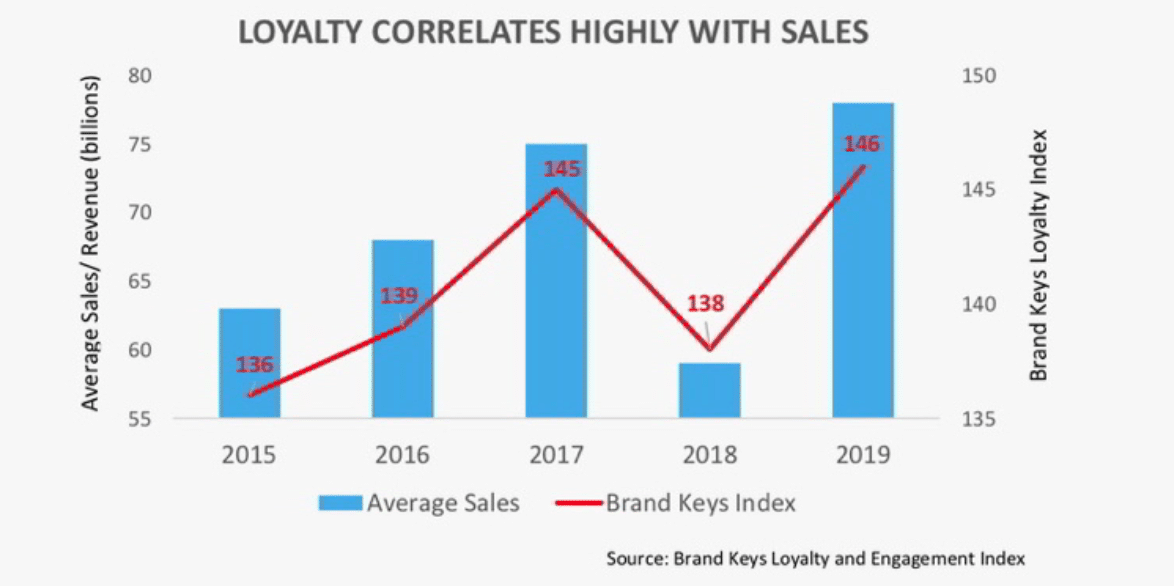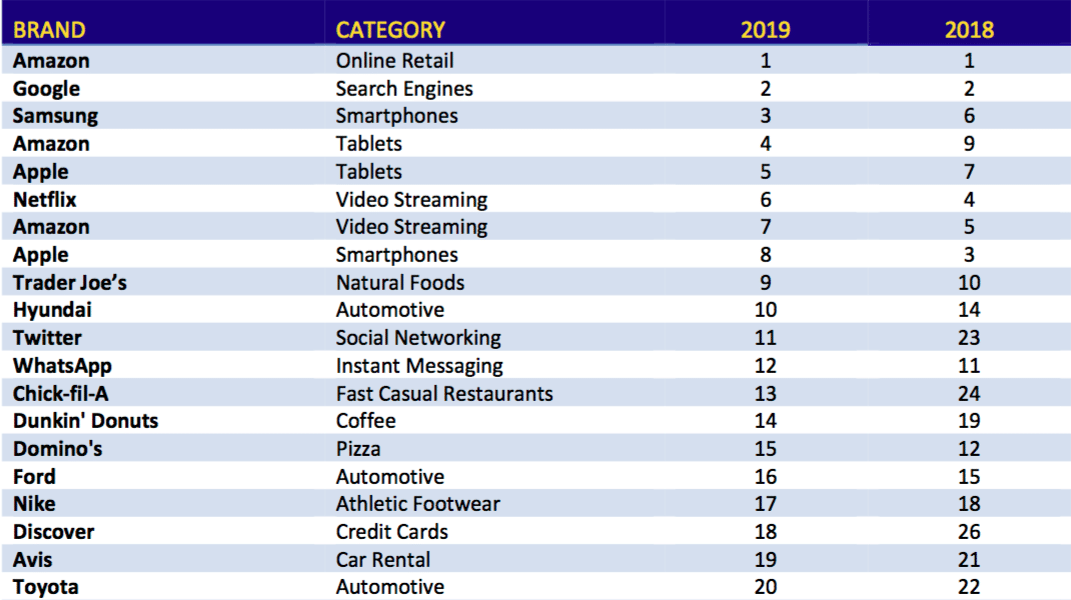With trends and drivers in a constant state of change, brand loyalty has become one of the most malleable goals among marketers and communicators—and metrics are morphing and evolving at variable speeds, depending on the audience.New research fromloyalty and customer engagement research firm Brand Keys provides a unique set of data proven to be the most accurate, cross-category perspective of brand loyalty available.
The 23rd annual Brand Keys Loyalty Leaders survey also examined 921 brands in 110 categories, and identifies the most diverse set of top 100 brands as loyalty leaders in over a decade.
Expansion in three areas alters brand loyalty paradigm
“Expansion in three critical marketing areas have altered the sector-terrain as far as brand loyalty is concerned,” said Robert Passikoff, Brand Keys founder and president, in a news release.
The three areas exhibiting massive expansion YOY have consequential effects on brands:
- Competitive sets
- Atypical increases in consumer expectations
- Opportunities for traditional and digital communication outreach and brand engagement.
“Anything that influences loyalty should be of material interest to marketers. Loyalty is six times more powerful than satisfaction, eleven times more accurate than recommendations, eighteen months ahead of focus groups and tracking studies, and can optimize brand marketing, advertising and media outreach by twenty percent. Significant changes in loyalty evaluations by the brand’s own customers confirm these findings,” said Passikoff.
First-time Top 100 appearances
When it comes to confronting “expansion,” brands able to define their frame of reference clearly and engagingly moved into the Top 100 Loyalty Leaders. This year marks the first-time appearance for seven brands including: Expedia (#73), Chobani (#83), PayPal (#95), Coca-Cola (#97), Konica-Minolta (#98), Dick’s Sporting Goods (#99), and Dollar Tree (#100).
“Given prevailing consumer views of gun control,” said Passikoff, “It isn’t a surprise that Dick’s Sporting Goods moved up by engaging consumers with their anti-assault weapon positioning. Being the first to remove assault weapons, high capacity magazines, and ‘bump stocks’ from their stores was a good beginning stance vis-à-vis the expansion of consumers’ anti-gun positions.”
More first-time brand-specific findings:
- Coca-Cola engaged consumers with an overall brand re-stage, which included new ad campaigns, new CSR, and new flavors.
- Konica-Minolta’s “Making the World Work” campaign spoke directly to the B2B community with the message the brand was there to back them up to succeed.
- Dollar Tree seems immune to any threat by Amazon (#1 again this year on the Loyalty Leaders List) due to a no-frills approach that meets consumers expanded expectations for value and convenience. Dollar Tree is opening 650 new stores in the midst of the biggest wave of bankruptcies and store closing in decades. “You need real loyalty to be able to do that,” noted Passikoff.
- Chobani’s in-house advertising has created a household engagement penetration of nearly 40 percent and is constantly—and positively—reinventing itself to meet consumers’ ever-expanding expectations.
In all instances, 2019’s First-Time brands have leveraged traditional and digital communication and engagement opportunities.

Returning loyalty leaders
Two brands—both in the Restaurant category—returned to this year’s Top 100 list: Chipotle (#94), after a 4-year absence, and McDonald’s (#68), after a 7-year hiatus. “Not many brands make it back into the Top 100 after absences this long but in these cases, it’s almost entirely due to the brands’ abilities to meet expanded consumer expectations,” said Passikoff.
Expectations for an all-day breakfast menu increased nearly 200 percent, and McDonald’s stepped up and delivered. Chipotle did a complete expectation re-set. “Call it Chipotle 2.0,” said Passikoff, noting expanded menus, delivery options, and new food platforms that have met expanded customer expectations.
Nine brands disappeared
Nine brands disappeared from the 2019 Top 100 Loyalty Leaders List due almost entirely to the expansion of competitive sets. These included:
- Airbnb
- Au Bon Pain
- Grand Theft Auto
- Papa John’s
- Reebok
- Tumblr
- Victoria’s Secret, and
- Zubrowka
Hotel chains have expanded Airbnb’s competitive set, with new brands to fill their portfolios between pricing and service levels, with some hotel chains adding home-sharing.
Expansion of vodka brands have added nearly 50 new players to their category in the past year.
“Papa John’s and Victoria’s Secret are outliers in that both brands suffered from negative publicity,” noted Passikoff. “But 5,000 new pizza parlors in the past year didn’t help, and Victoria’s Secret now faces competition from brands like Aerie, True & Co., Journelle, and even J. Crew.”
Loyalty predicts sales
In addition to fostering new loyalty levels, the returning and first-time brands have kept customers buying, attracted new consumers, and driven sales to new highs. “They accomplished that by managing the expansion of competitive challenges, vastly amplified consumer expectations, and by engaging consumers via both traditional and digital outreach,” noted Passikoff.
Predictive loyalty and engagement metrics are of greater utility than traditional tracking studies. “Brands not only gain deep insights into how they can specifically activate to grow their businesses and can gauge performance in relation to marketplace ‘expansions,’” he added. “Loyalty assessments can turn tracking into prediction.”
Brands that meet these expansion demands, and make loyalty a strategic priority always appear on the Loyalty Leaders List. “More importantly, they always appear at the top of consumers’ shopping lists because loyalty is a leading-indicator of behavior and sales. Loyalty always predicts business outcomes with exceptionally high correlations to sales, traffic, and KPIs crucial to brands across categories, 0.86 in the five-year CPG category example below,” said Passikoff.

See the complete 2019 Top 100 Loyalty Leaders List here.
“The good news is brand loyalty is logical and easily understood. The better news is loyalty and engagement can be quantified, predicted, and integrated into a brand’s research efforts,” said Passikoff. “The best news is loyalty metrics correlate highly with customer attitudes, behavior, sales, and profitability.”
The Brand Keys Loyalty Leaders analysis was conducted in August 2019 and included 55,115 assessments (M/F, 16 to 65 YOA, recruited from the nine US Census Regions). Respondents self-selected categories in which they are consumers and assessed the brands for which they are customers. The 2019 Loyalty Leader survey assessed 110 categories and 921 brands. Unlike economic use models, which rely on historical data and profitability conjecture, the Brand Keys’ rankings are 100% consumer-driven, measuring real-time emotional andrational aspects of the consumer’s decision process.



